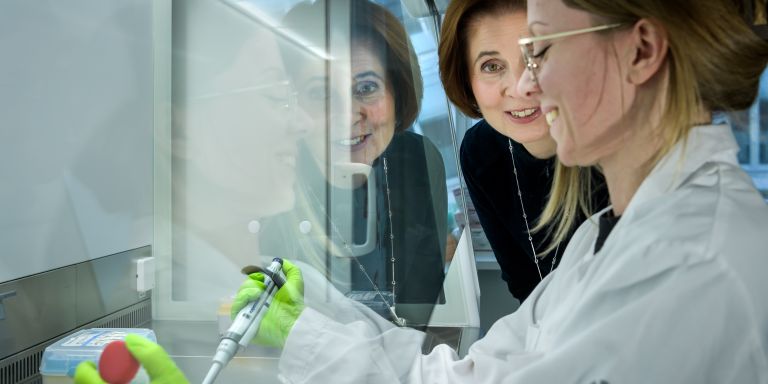
Anna Blom
Professor of Medicinal Protein Chemistry
Wallenberg Scholar
Institution
Lund University
Research field
The complement system, diabetes, cancer, infections, rheumatism


Wallenberg Scholar
Institution
Lund University
Research field
The complement system, diabetes, cancer, infections, rheumatism
The immune system we are born with includes the complement system, made up of about 40 proteins that circulate in the blood where they fight invaders and clean away debris. C3 is one of the most important complement proteins. Not only is it present in the blood, it is also found inside cells, which is what Blom studies.
“C3 in the blood protects us but it also creates problems. After all, you don’t feel well when you suffer from an infection or inflammation, and this can largely be due to C3. But inside cells, this protein appears to only protect us. This was rather unexpected,” says Blom, professor in medicinal protein chemistry and a Wallenberg Scholar at Lund University.
Today, there are drugs called complement inhibitors, which are used specifically to inhibit the complement system in the blood when it becomes so active that it risks causing damage. But inside cells, it’s a different story. One of the things Blom’s group studies is C3 in the beta cells of the pancreas, where diabetes starts.
“It appears that C3 has several functions in beta cells that provide protection against diabetes,” explains Blom.
One of the processes that is disturbed in diabetes is called autophagy, when the cell “eats” its old and damaged organelles. In beta cells, this process is not very effective if the amounts of C3 present are too low. C3 also appears to defend cells against attack from interleukins, which are signaling substances secreted by immune cells during infection or inflammation.
Beta cells may die in when they come under attack – but if they contain C3, they are protected. In studies on mice, genetically modified so that they lack C3 only in beta cells, Blom and her colleagues have shown that they develop diabetes much more easily than mice that still have the protein.
Blom’s group also works with material from patients, including donated tissue from pancreatic glands. She gets this from Lund University’s diabetes center (LUDC) – a collaboration that Blom is very happy about.
“I didn’t know much about autophagy and beta cells initially, but the researchers there are so generous with their knowledge and their data collections! My group brainstorms with them before we start our experiments to hear if our ideas are completely crazy. It’s quite refreshing for me to have colleagues like that and not have to do everything myself.”
Blom has been researching complement proteins in cells for ten years. For a long time, her field was both narrow and contested.
“Many people had difficulty accepting that complement proteins such as C3 actually existed intracellularly, and that they function completely differently there compared to in the blood. It’s a different environment, so the protein binds to other molecules. The funny thing is that the new functions we’re discovering now seem to be, evolutionarily speaking, really old ones that were present in the cells even before more complex organisms began to develop immune systems.”
Drugs that are linked to the complement system today are inhibitors, directed against proteins in the blood. What we see is that sometimes more C3 is needed inside cells.
As recently as a few years ago, Blom’s hypotheses were so controversial that at a conference she had to participate in a session that focused entirely on the controversy surrounding complement proteins in cells.
“I had to stand alone and defend my research and the entire field in front of a couple hundred people, it was an experience! But it is becoming increasingly accepted. Nowadays, major conferences on the subject usually have a special session on intracellular complement and more and more groups are working on it. But, when it comes to diabetes, we are the only ones focusing on it.”
Blom grew up in Poland and began her training at the University in Krakow. Her mother was also a scientist, and Blom already saw as a child how passionate her mother was about her subject. It felt natural to follow in her footsteps. A chance to write a Master’s thesis at Uppsala University took Blom to Sweden. She liked the values she encountered in Swedish academia and ended up staying. In 2006, she gained her professorship in Lund and built up a research environment around the complement system in several different diseases.
“I’m stubborn. As a researcher you have to be. And strategic. I don’t think it should be necessary, but unfortunately it is. You need to be able to adapt your projects to the funding and conditions that exist, and this often does not favor challenging, risky projects that require a long-term approach. So, it’s fantastic to receive a five-year grant from the Knut and Alice Wallenberg Foundation.”
When the pandemic hit, that pressure intensified. How could an experimental group like Blom’s continue their work if they were not allowed to come to the lab? But it worked out, with careful planning and flexible working hours to avoid crowding.
“All the administrative meetings and conferences that didn’t happen really freed up time for the research. It was such fun! Working with my young colleagues is one of the best things I know. When I was a young researcher myself, I thought that everyone wanted the same thing as me and followed the same path, but people have completely different goals. To guide them through that journey is extremely rewarding.”
Text Lisa Kirsebom
Photo Kennet Ruona
Translation Nick Chipperfield